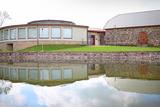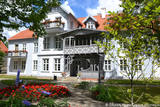| Nr | Nosaukums | Apraksts |
|---|---|---|
|
Pārgājiens laikā un telpā, jo taka uzskatāmi attēlo šīs vietas vēsturi kopš brīža, kad atkāpās Ledājs – iespaidīgās Gaujas senlejas veidotājs. Smilšakmens iežu atsegumi aizved vairāku simtu miljonu senā vēsturē – Devona periodā, ko sauc arī par „zivju laikmetu”. Bet pavisam nesen šeit parādījās cilvēks, kas arī atstājis savas pēdas. Kā viens no takas apskates objektiem ir 13 m garā Svētavota ala, no kuras iztek Svētavots. |
||
|
Siera fermā Andre ražo un pārdod sierus, kas guvuši augstu novērtējumu visas pasaules mērogā. Kvalitatīvo un garšīgo pienu iegūst no laimīgām fermas govīm. Fermas apmeklētāji var apciemot un paglaudīt govis, kā arī pavērot slaukšanas procesu. Mazajā zemnieku saimniecības veikaliņā var nopirkt gan sierus, gan citu vietējo mazo ražotāju bioloģiskās lauksaimniecības produktus. |
||
|
Moderns un mūsdienīgs centrs apvienojumā ar vēsturisku klēts ēku veido unikālu kompleksu, kurā ir vēsturiska ekspozīcija par amatniecību, Līvānu stikla muzejs, izstāžu zāle, garākā josta Latvijā, iznomājama konferenču zāle, ūdens galerija. Radošajās keramikas, stikla darbnīcās darbojas novada amatnieki, kurus var vērot darbībā un līdzdarboties. Centra telpās izveidota un darbojas vienīgā Latvijā publiski pieejamā stikla pūtēju darbnīca. |
||
|
Lielā dziesmu vieta "Dzintari" ir ievērojama ar to, ka tieši tur 1866. gadā norisinājās pirmie latviešu skolēnu koru svētki. Lai iezīmētu šo vietu, 2015. gada vasarā Madonas novada, Praulienas pagasta, Šūpuļkalnā (Madona – Varakļāni ceļa malā) tika uzstādīts Ivara Mailīša veidotais vides objekts “Latvija skan”. Šajā vietā atrodas arī māja, kurā dzīvojis ievērojamais koru virsdiriģents Haralds Mednis (1906-2000). Lai saglabātu mākslinieka piemiņu, 2016. gadā durvis vēra Haralda Medņa 20. gs. 30. gados uzceltā māja “Dzintari”. Tajā apskatāma izstādes par virsdiriģentu Haraldu Medni un Pirmajiem latviešu skolēnu koru svētkiem. Vietai dots skanīgs nosaukums – Lielā dziesmu vieta “Dzintari”. |
||
|
Par valgumu jeb sedumu sauca šauro smilšaino piekrastes joslu starp kāpu un ūdeni. Katram ciemam bija vairāki valgumi – laivu piestātnes ar vabām tīklu žāvēšanai. Valgumiem 20.gs. 20.-30.gados bija liela nozīme līvu valodas un etniskās apziņas uzturēšanā. Tolaik lībiešu ciemos jau dzīvoja daudz latviešu, taču viņi maz darbojās zvejniecībā, tādējādi valgumos joprojām galvenā saziņas valoda bija lībiešu. |
||
|
Mailīšu fabrika atrodas Ērgļos, un tā ir radīta ar mērķi saglabāt rokdarbu tradīcijas un prasmes. Te auž vilnas, lina un zīda darbus - segas, plecu lakatus, linu dvieļus. Viesiem ir iespēja apskatīt dažādu veidu stelles, kuras izmantotas Latvijas teritorijā jau sākot no 9.gs. |
||
|
Brīvdienu māja "Rūķīši" atrodas ainaviskā vietā pie Rugāju ūdenskrātuves. Saimnieks audzē un pārstrādā zivis. Klāj galdus, kuros ir latgaļu ēdieni. Sadarbojas ar zemniekiem un zvejniekiem. Latviešu virtuve: Kūpinātas zivis (karpa, Peipusa vēdzele, līnis, sams, breksis). Brekšu konservi. No karpas, līņa un brekša vāra zivju zupu. Putraimu biezputra ar kūpinātu gaļu, pašcepta rudzu maize, uz vietas gatavoti sieri. Īpašais ēdiens: gulašzupa no līņa. |
||
|
Kādreizējais tanku poligons, par kuru mūsdienās vairs vēsta tikai netiešas liecības (sk. stāstu).
|
||
|
Atrodas Bauskas centrā, Kalna iela 6. Muzeja piedāvājumā ir ekspozīcija „Bauska laikā un cilvēki Bauskā 20 gs., pastaiga un atraktīvs piedzīvojums”. |
||
|
Maršruts ilgst 12 dienas, ar privāto auto transportu. Kopējā maršruta distance ir 1 500 km. |
||
|
Iepretim Marijas salai (Pilssalai) paceļas ap 30 m augstais un stāvais (nogāzes mākslīgi nostāvinātas) Tempļa kalns - ar sānu gravām norobežots sens latgaļu pilskalns. Ap 80 m garajā un līdz 40 m platajā pilskalnā izšķirami vairāki mākslīgi veidoti vaļņi. Viena no senākajām Tempļa kalna apkaimes apdzīvotības liecībām ir atrastais cirvis, kas datēts ar 2. – 3. gadu tūkstoša miju pr. Kristus. Arheologi uzskata, ka šajā laikā cilvēki dzīvojuši Pilssalā. 10. – 11. gs. pilskalnā atradusies latgaļu pils, kuru 1225. g. nopostīja krustneši. Pilskalna virsma ir pārveidota arī salīdzinoši nesenā laikā - 1807. g. - granīta rotondas būvniecības laikā. Rotonda celta, godinot krievu feldmaršalu Šeremetjevu un zviedru kapteini Vulfu. Skats no Tempļa kalna uz Alūksnes ezeru un pilsētu ir viens no skaistākajiem Vidzemē. Ievērības cienīgs ir 1937. g. celtais Saules tilts. No Tempļa kalna ir vērts aiziet līdz netālu esošajam 37,8 m augstajam koka skatu tornim. Asāku izjūtu cienītājiem tiek piedāvāts gaisa trošu nobrauciens “Zzzippp” pāri Alūksnes ezeram. |
||
|
Dodieties ekskursijā, lai gūtu ieskatu lauku profesijā un dzīvesveidā, kā arī iegūtu jaunus iespaidus un labu atpūtu visai klasei. Ekskursijas laikā apciemojiet koka skulptūras Vienkoču parkā, kur iespējams iepazīties arī ar koka amatniecību un sameklēt dārgumu lādi. Vai arī apmeklējiet vienīgo vietu Baltijā, kur var iepazīties ar cilvēku dzīves apstākļiem pirms vairāk kā 1000 gadiem. Pēc tam apmeklējiet zemnieku saimniecību, kurā no cidonijām ražo sukādes, marmelādes, sīrupus un citus labumus, un pļavās ganās savvaļas zirgi. Ekskursijas noslēgumā dodieties uz Porcelāna fabriku, lai varētu padarboties apgleznošanas darbnīcā un iepazīties ar ražotni. |
||
|
Ekskursijas sākumā apmeklējiet Enerģētikas muzeja ekspozīciju Pļaviņu hidroelektrostacijā, kur iespējams iepazīties ar unikālās būves un lielākās elektroenerģijas ražotnes Baltijā celtniecības vēsturi un darbības nozīmīgākajiem notikumiem. Pēc tam apmeklējiet Skrīveru pārtikas kombinātu, kurā iespējams iegādāties gardās konfektes un doties ekskursijā. Tālāk - Skrīveru mājas saldējums ar stāstījumu par saldējuma gatavošanu un degustācija. Brauciena noslēgumā dodieties uz savvaļas dzīvnieku dārzu, kur dzīvo ~ 50 dambrieži un Skotijas savvaļas govis. |
||
|
Vijciema Medību pils ēkā iekārtots elegants dizaina viesu nams Bergervilla. Katrs numurs ir ar individuāli veidotu dizainu, vēsturiskām mēbelēm un īpašu atmosfēru. Pieejami 4 numuri – standarta numurs, divu istabu apartaments un divi Delux klases numuri ar privātu balkonu un vannu. Katram numuram dots meža zvēra vai putna vārds – Pūce, Mednis, Briedis un Alnis. Viesu atpūtai tāpat pieejama viesistaba un bibliotēka, kā arī pilnībā aprīkota virtuve maltīšu pagatavošanai. Pieejams bezmaksas Wi-Fi un autostāvvieta. |
||
|
Naktsmītnē Elly, Kihnu salā gatavo mājas saldējumu, piedāvā arī naktsmītni un gardas mājas brokastis. |
||
|
Saimniecības laukos vasaras vidū zied rapši un lini. To apstrādei uzbūvēta rapšu un linu sēklu eļļas spiestuve. Eļļas spiešanas procesa vērošana, eļļas iegāde.
|
||
|
Jaukā, skaistā vietā Vaidavas pagastā Gaujas Nacionālā parka teritorijā ir apskatāmi seni darbarīki, mehānismi, sadzīves priekšmeti. Stāstījums par to darbības principiem un pielietojumu. Piedāvā arī nakšņošanu viesu mājā, telts vietas, piknika vietas.
|
||
|
Šilutes muižu mūsdienās mēdz saukt tā pēdējā saimnieka vārdā – Hugo Šoja muiža. Šilutes muižnieks, parka izveidotājs Hugo Šojs (Scheu) muižu iegādājās 1889.gadā. Viņš atjaunoja muižas ēkas un apkaimi, tāpat izveidoja 2 parkus: muižas un par “kraukļu mežu” saukto meža parkus. Muižai blakus izveidoja angļu tipa parku ar pastaigu takām. Meža parks, veltīts iedzīvotāju pastaigām, izveidots abās Šišos līkumotās upes pusēs, ko savieno gājēju tilti. Parkā, kas izpleties gar Šišes upi līdz senajam dzelzceļa tiltam, atrodamas ap 150 augu sugas. Šobrīd parkā ir 40 koku sugas un krūmi. |
||
|
Savā ziņā unikāls un Baltijas valstīs vienīgais šāda veida 17. - 18. gs. mazpilsētas apbūves komplekss, kas izvietojies mazās Alekšupītes krastos. Dažviet upīte tek gar ēku sienām. Šī pilsētvide ar tiltiņiem radījusi apzīmējumu – „Latvijas Venēcija”. Interesantiem kultūras pieminekļiem bagātas ir Baznīcas, Liepājas, Kalna u.c. ielas. |
||
|
Viengadīgo krāšņumaugu, ēdamaugu dēstu audzēšana. Dažādu krāsu un formu tomātu audzēšana segtajās platībās. Ar 2021. gadu tomātu pārstrāde - sulas un pulvera ražošana. |
||

























